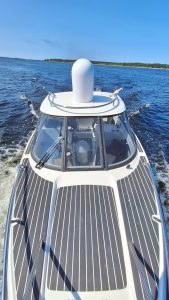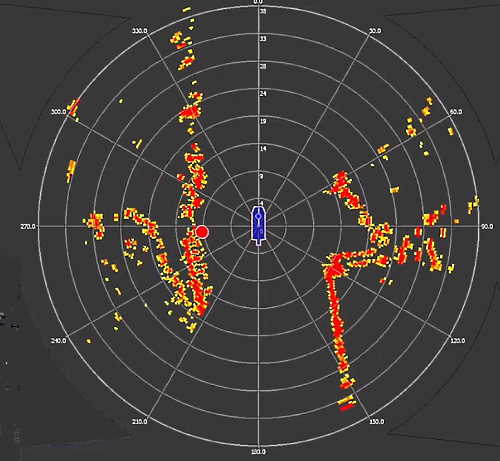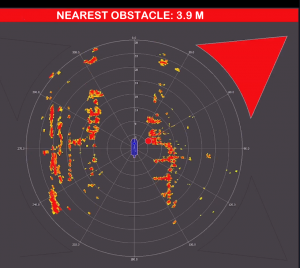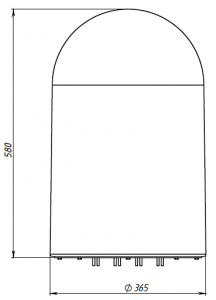Why a short-range E-band mm-wave maritime radar is a must for an unmanned vessel
Are you interested in technology to navigate drone boats safely and efficiently? ELVA-1 introduces E-band SDM360-76 short-range radar, which can revolutionize drone boat navigation and make autonomous shipping easier and safer than ever before.
E-band short-range marine radar is a new technology that enables you to navigate unmanned vessels, including electric drone boats, with unparalleled accuracy and safety, while reducing operational risks associated with maritime activities.
Let’s first start with some terms:
– An unmanned surface vehicle (USV), also known as an unmanned surface vessel or uncrewed surface vessel, is commonly referred to as a drone boat or drone ship. These boats or ships function on the water’s surface without any crew onboard.
– USVs can operate with varying degrees of autonomy, ranging from remote control to completely autonomous surface vehicles (ASV).
Today advances in USV control systems and navigational technology have led to USVs that the operator can control remotely from land or a nearby vessel.
Modern USV and ASV applications and research include:
- autonomous commercial shipping,
- intra-port delivery,
- environmental and climate monitoring,
- coastal small ferry service
- robotic research and surveillance,
- bridge inspection,
- other infrastructure operations for trade and transportation, environmental protection, and science.
Short-range radar without a blind spot as boat designer’s choice
 It’s pretty simple to explain why boat designers and engineers need short-range radar without a blind spot for an unmanned vessel. If the boat is in open waters, it can navigate using GPS satellite signals, but when leaving a berth or arriving at a mooring point, it needs special moving accuracy.
It’s pretty simple to explain why boat designers and engineers need short-range radar without a blind spot for an unmanned vessel. If the boat is in open waters, it can navigate using GPS satellite signals, but when leaving a berth or arriving at a mooring point, it needs special moving accuracy.
In addition, the short-range radar allows to respond autonomously or through the remote operator to unexpected obstacles, such as manoeuvres of other ships or boats on an oncoming or crossing course, It is especially important to have a radar picture of the detailed navigational situation in cases of operation in fog, blizzard, and at nighttime.
Next, it is important to explain why designers and engineers need millimeter-wave radars to control boat drones, particularly those radars operating in the E-band. Traditional marine radars, so-called X-band and S-band radars, can see far away for dozens of miles, but not at the very side of the ship because they have a blind spot there. The size of a blind spot is usually from a quarter of a nautical mile to at least 20 m. For example, some of the most popular compact radars for boats, the Furuno 1623 and Furuno DRS4W, have a blind spot zone of 22 m around the boat. If you need to see the situation in the near zone, such as 1, 5, or 12 meters close by, then you need more advanced radar technologies with ultra high resolution capability.
The resolution of the radar is determined by the width of the occupied band with linear frequency modulation. ELVA’s radar occupies 1 GHz in the authorized band of 76-77 GHz compared to competitors offering radars at 24 GHz where only 0.2 GHz bandwidth is authorized.
When an unmanned vessel needs to navigate a few meters close to the side, a particularly accurate close-range radar is required, and this is where E-band radar comes in. For example, ELVA’s E-band SDM360-76 radar, operating at 76 GHz, is used to provide clear navigational awareness with 15 cm resolution over a typical range from zero to 600 meters, or in other words, from the edge of the boat to 0.32 nautical mile (nm).
ELVA-1 mm-Wave E-band Marine Radar Features
1. Digital output of marine radar
2. Radar operational range: 0 to 600 m (0-0.32 nm)
3. Zero blind spot of a 76 GHz E-band marine radar
4. 15 cm resolution for advanced navigational safety
5. Compact size of E-band marine radar
6. 100 mW radiation power of E-band marine radar
7. Ability of 76 GHz E-band marine radar to detect a carbon or wood boat
1. Digital output of E-band short-range marine radar
The Ethernet digital output of marine radar is crucial for drone boats in order to deliver radar images to be displayed on the remote operator’s dashboard and in third-party applications that support an open data format.
Here’s why this capability is important:
- Seamless Data Transmission: Ethernet digital output ensures that the radar data is delivered in real-time, enabling immediate processing and visualization.
- Remote Operator’s Dashboard: Ethernet digital output enables the operator to have a comprehensive and up-to-date view of the maritime environment.
- Third-Party Applications: Radar images integrated into third-party applications expand the possibilities for data analysis, enhancing the overall capabilities of the drone vessel.
Overall, the Ethernet digital output of marine radar for unmanned surface vessel enables real-time data transmission, enhances situational awareness, and ensures flexibility for future developments in the field of autonomous shipping.
2. Up to 600 m detection range of E-band short-range marine radar
 100 m view scale at remote dashboard
100 m view scale at remote dashboard
One of its key attributes is ELVA-1 SDM360-76 E-band radar range, extending from the boat side up to 600 meters. This impressive range enables the radar to capture detailed information about the surrounding maritime environment, allowing for a comprehensive understanding of the vessel’s surroundings.
With a radar range of up to 600 meters, the drone boat’s radar can detect and track objects such as other vessels, buoys, obstacles, and potential hazards within this specified radius. Furthermore, the marine radar system incorporates a beam width of 15 degrees in elevation and 2 degrees in the azimuth direction. The 15 degree beam width on the elevation axis is needed to work out the rocking of the boat. This configuration enhances the radar’s precision and accuracy in capturing and analyzing objects within its field of view. The narrow beam width enables the radar to focus its energy and scan with a higher level of detail, resulting in a clearer and more refined situational awareness picture.
The 15-degree beam width in elevation ensures that the radar has an optimized vertical coverage, enabling it to detect objects with varying heights or those present at different altitudes. This is particularly valuable in scenarios where the drone boat needs to navigate through areas with bridges, overpasses, or other structures with varying elevation levels.
In the azimuth direction, the 2-degree beam width allows for precise tracking and localization of objects in the horizontal plane. This narrow beam width aids in distinguishing between closely spaced targets, enabling the radar to provide accurate position, speed, and course information of nearby vessels or objects.
3. Zero blind spot of ELVA-1 76 GHz E-band marine radar
The concept of a zero-size blind spot in unmanned vessel navigation is crucial for ensuring the safety and efficiency of the vessel’s operation. Here’s why it holds significance:
- Obstacle Detection: By configuring a short-range E-band maritime radar to take into account the size and contours of an unmanned vessel, it becomes possible to detect obstacles near the vessel without any blind spots.
- Uninterrupted Situational Awareness: Having a zero-size blind spot enables the remote operator to have a complete and real-time understanding of the vessel’s environment, ensuring timely responses to potential hazards or obstacles.
- Multiple Radar Installation: For larger unmanned vessels, it is possible to install radars on different sides, such as the bow and stern, and combine their readings into a single navigational picture. Multiple radars are used because the ship has superstructures and mast structures that obscure the radar’s field of view. Therefore, often two radars on different sides of the ship can be used to eliminate signal shading, e.g. from the wheelhouse.
In summary, the zero-size blind spot concept allows comprehensive obstacle detection, uninterrupted situational awareness and accurate distance measurement.
4. E-band radar remarkable resolution of 15 centimeters

The mm-wave marine radar system provides high-resolution situational awareness with remarkable accuracy of 15 centimeters on up to 600 meters range, making it an invaluable tool for unmanned vessels to safely navigate in challenging environments. Here’s why this feature holds significant importance:
- Space Efficiency: The compact size of the marine radar enables efficient utilization of space on unmanned vessels. The compact dimensions ensure that the radar can be easily integrated into the vessel’s structure.
- Lightweight Design: In addition to its compact size, the marine radar’s lightweight design provides further benefits. It minimizes the overall weight added to the unmanned vessel.
- Versatile Mounting Options: The smaller size of the marine radar opens up versatile mounting possibilities on unmanned vessels. The radar can be easily installed in various locations, such as the vessel’s mast, cabin roof, or any suitable elevated position.
Millimeter wave E-band marine radar system allows for precise distance measurement, collision avoidance, and efficient maneuvering, ensuring the vessel’s smooth passage through challenging maritime conditions.
5. Compact size of E-band marine radar
 The compact size of ELVA-1 SDM360-76 E-band marine radar, measuring 580 mm in height and 365 mm in diameter, brings numerous advantages to unmanned vessel operations. Here’s a closer look at why this feature holds significant value:
The compact size of ELVA-1 SDM360-76 E-band marine radar, measuring 580 mm in height and 365 mm in diameter, brings numerous advantages to unmanned vessel operations. Here’s a closer look at why this feature holds significant value:
- Space Efficiency: The compact size of the marine radar enables efficient utilization of space on unmanned vessels. The compact dimensions ensure that the radar can be easily integrated into the vessel’s structure.
- Lightweight Design: In addition to its compact size, the marine radar’s lightweight design provides further benefits. It minimizes the overall weight added to the unmanned vessel.
- Versatile Mounting Options: The smaller size of the marine radar opens up versatile mounting possibilities on unmanned vessels. The radar can be easily installed in various locations, such as the vessel’s mast, cabin roof, or any suitable elevated position.
6. 100 mW radiation power of E-band marine radar
The compact marine radar boasts an impressive feature that combines a low radiation power of 100 milliWatts utilising Frequency Modulated Continuous Wave (FMCW) modulation. Here’s why this feature is noteworthy:
- Environmentally Friendly: The combination of low radiation power and FMCW modulation contributes to an environmentally friendly solution. By minimizing electromagnetic radiation emissions, the radar helps reduce its impact on the people and surrounding environment.
- User-Friendly Deployment: The radar’s safe radiation power level simplifies the deployment process, as it eliminates the need for additional safety measures or special protective equipment during installation or maintenance.
To sum up this functionality,, the radar’s low radiation power (100 mW) with FMCW modulation ensures a safe operational environment while maintaining reliable performance.
7. E-band marine radar ability to detect carbon or wooden boats
The 76 GHz E-band marine radar, featured with its advanced frequency range, offers the unique capability to detect and identify carbon or wood boats. While each material presents its own challenges, the radar’s high frequency enables effective detection through specific mechanisms. Let’s explore further:
- Detecting Carbon (Fiberglass) Boats: Fiberglass, commonly used in carbon boats, is known for its radio transparency. This property makes fiberglass boats difficult to detect using conventional radar systems. However, the 76 GHz E-band marine radar leverages the high radar frequency to overcome this challenge. Various components on the boat, such as the engine, rigging, and deckhouse, create glare spots due to their different reflective properties. These glare spots allow the radar to identify and detect the fiberglass boat effectively.
- Identifying Wooden Boats: Unlike fiberglass boats, wooden boats offer more radio detectability. The radar can identify a wooden boat not through radio signal glares but by reflecting the radar signals from the boat hull.
- Navigational Benefits: The ability to see carbon or wood boats using the marine radar brings significant navigational benefits. For unmanned vessels, it enables safer navigation in the presence of these boats.
In summary of this feature, the 76 GHz E-band marine radar offers valuable advantages in detecting and identifying carbon or wood boats, which can be challenging for traditional radar systems.
